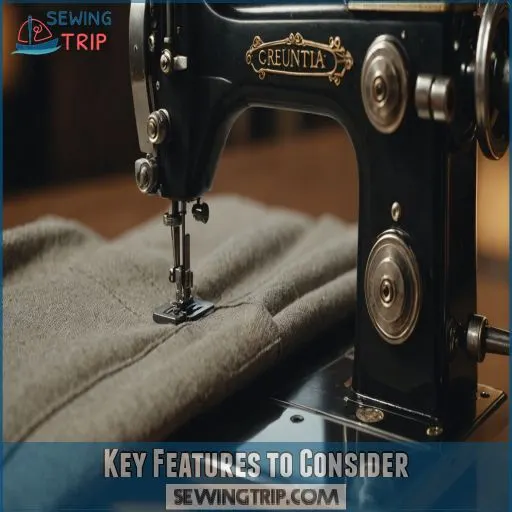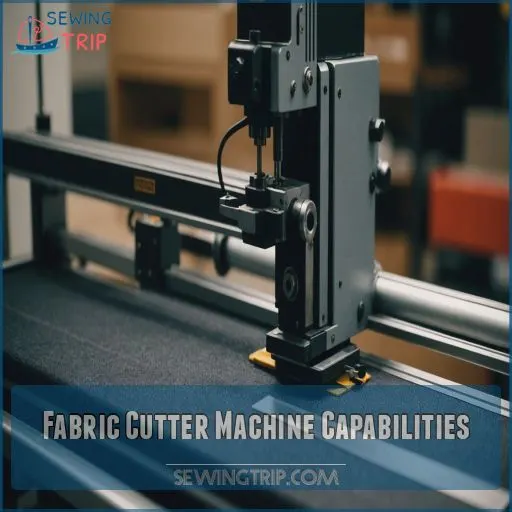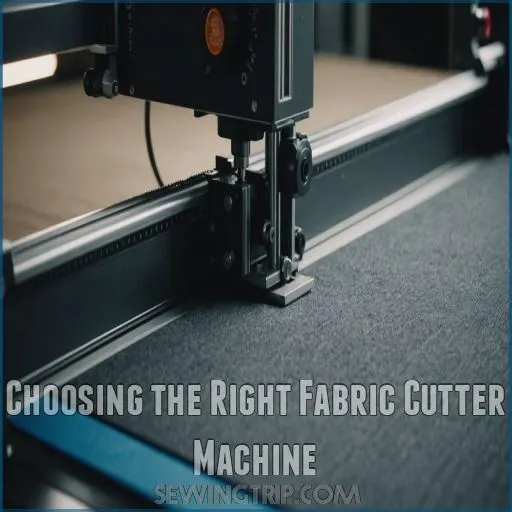This site is supported by our readers. We may earn a commission, at no cost to you, if you purchase through links.
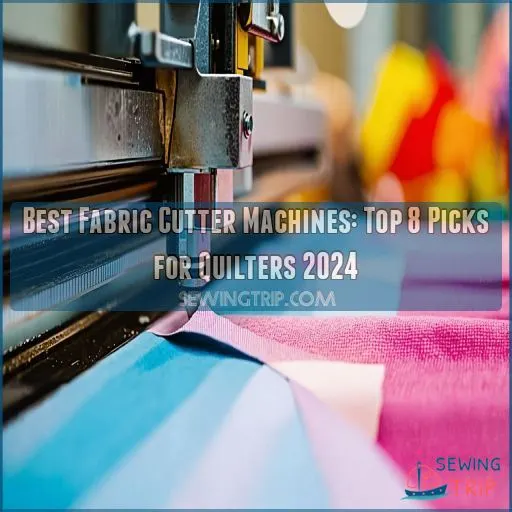 You’re on the hunt for the best fabric cutter machine, and you’ve got options.
You’re on the hunt for the best fabric cutter machine, and you’ve got options.
Top picks like the Sizzix Big Shot Express and Cricut Maker 3 offer precision cuts that’ll make your quilting buddies green with envy.
Looking for speed? The AccuQuilt system slices through fabric 90% faster than scissors – talk about a time-saver!
Consider whether you want manual or electronic, and don’t forget to check the cutting mechanism. From rotary blades to die-cutting, each has its perks.
Remember, the right machine isn’t just about clean cuts; it’s about boosting your creativity and efficiency. Stick around to discover how these fabric-slicing wizards can revolutionize your crafting game.
Table Of Contents
- Key Takeaways
- Top 8 Best Fabric Cutter Machines
- 1. Sizzix Big Shot Express Die Cutting Machine
- 2. AccuQuilt Beginner Fabric Cutting System
- 3. Cricut Maker 3 Smart Cutting Machine
- 4. Brother ScanNCut SDX85S Cutting Machine
- 5. Silhouette Cameo 4 Cutting Machine
- 6. Cricut Maker 3 Bundle with Images
- 7. Cricut FabricGrip Cutting Mats
- 8. Sizzix Big Shot Plus Die Cutting Machine
- Key Features to Consider
- Fabric Cutter Machine Capabilities
- Choosing the Right Fabric Cutter Machine
- Frequently Asked Questions (FAQs)
- Conclusion
Key Takeaways
- You’ll find a wide range of fabric cutters, from manual to electronic, each with its own strengths. It’s like choosing between a trusty Swiss Army knife and a high-tech gadget – pick the one that fits your quilting style and budget.
- Don’t just focus on the blade – consider features like cutting area, speed, and safety. A larger cutting area lets you tackle bigger projects, while safety features ensure you keep all your fingers for your next quilting bee.
- Maintenance is key to keeping your fabric cutter in tip-top shape. Think of it as giving your crafting sidekick a spa day – regular blade checks and oiling will keep it running smoothly.
- With the right fabric cutter, you’ll boost your efficiency and creativity. You’ll be churning out quilts faster than you can say "a stitch in time," turning piles of fabric into precise pieces with the flick of a wrist.
Top 8 Best Fabric Cutter Machines
You’re about to discover the top fabric cutter machines designed to work with rotary cutter tools that can transform your quilting projects from overwhelming to delightful
.
Whether you’re after speed, precision, or versatility, these picks are bound to make your crafting adventures smoother and more enjoyable.
1. Sizzix Big Shot Express Die Cutting Machine
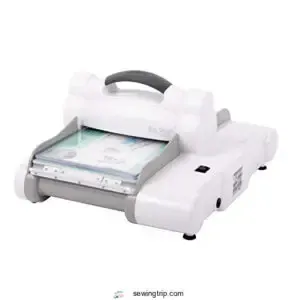
The Sizzix Big Shot Express is a fabric cutter you’ll adore if you value ease and precision. With the push of a button, this electric machine cuts and embosses materials up to six inches wide, perfect for your quilting projects.
It’s especially favored by those with arthritis, as there’s no need for cranking.
While its motorized design impresses, the power cord can be a bit tight initially.
Best For: The Sizzix Big Shot Express is best for crafters and quilters who want a user-friendly electric die-cutting machine for precise cuts.
- Electric operation for effortless cutting and embossing.
- Designed for both beginners and experienced crafters.
- Quiet operation for a more pleasant crafting experience.
- Compatibility issues with some Sizzix dies (Bigz Plus and Bigz Pro).
- Some users report issues with cutting accuracy and durability.
- Power cord connector can be tight initially.
2. AccuQuilt Beginner Fabric Cutting System
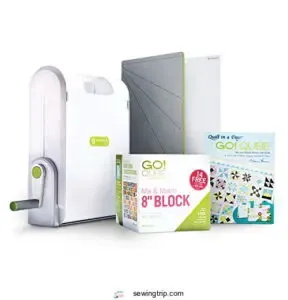
Ready to tackle your quilting projects with ease?
The AccuQuilt Beginner Fabric Cutting System offers you a seamless experience, cutting multiple fabrics like cotton, wool, and even denim.
Imagine slicing through fabric with precision and speed—90% faster than scissors!
It comes with a GO! cutter, eight unique shapes, and two mats, plus over 70 free patterns.
Though a bit of an investment, it pays off by saving you huge time and effort.
Just watch out for those sharp dies!
Best For: The AccuQuilt Beginner Fabric Cutting System is best for quilters who want to streamline their fabric cutting process and achieve precise, consistent results.
- Offers fast and accurate fabric cutting, saving time and effort.
- Includes a variety of cutting shapes and free patterns for diverse quilting projects.
- Durable and easy to use, making it suitable for both beginners and experienced quilters.
- The dies can be expensive, adding to the overall cost of the system.
- Some cuts may still require additional precision, depending on the project.
- The sharp dies require careful handling and are not suitable for small children.
3. Cricut Maker 3 Smart Cutting Machine
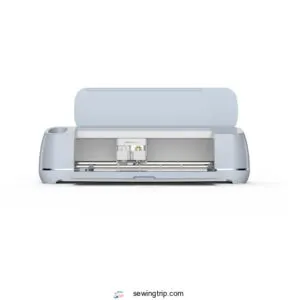
Imagine crafting a masterpiece in record time with the Cricut Maker 3.
This mighty machine cuts over 300 materials, from delicate fabric to rugged leather, offering precise, fast, and versatile results.
It’s your perfect crafting partner, handling intricate designs with ease and speed—two times faster than its predecessor.
You can explore endless creative possibilities with Smart Materials, making long cuts up to 12 feet without a mat.
Explore the Cricut Design Space and let your creativity flow effortlessly!
Best For: The Cricut Maker 3 is best for crafters who want a powerful, versatile machine that can handle a wide range of materials and projects.
- Speed: Cuts projects twice as fast as the previous model.
- Versatility: Compatible with over 300 materials and 13 tools.
- Smart Materials: Makes long cuts up to 12 feet without a mat.
- Cost: Cricut Access is a paid subscription service.
- Software: May not be suitable for advanced users who prefer open interfaces.
- Weight: The machine is quite heavy, which could be a concern for some users.
4. Brother ScanNCut SDX85S Cutting Machine
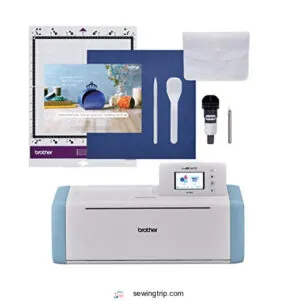
One cutting machine that’ll make your quilting dreams come true is the Brother ScanNCut SDX85S for precision fabric cutting techniques
.
With its built-in scanner, you can turn your hand-drawn designs into unique cut-outs – no computer required! Plus, the Auto Blade Sensor automatically adjusts to the thickness of your material, so you don’t have to fuss with manual settings.
At just 12 lbs, this compact machine packs a punch, with 251 built-in designs and wireless connectivity to boot.
Craft right out of the box and make every moment special with the ScanNCut DX.
Best For: Crafters and quilters who want a user-friendly cutting machine with a built-in scanner and wireless connectivity.
- Easy to use
- Versatile
- Compact
- Difficulty finding accessories and replacement parts
- High cost of accessories
- Japanese manual not user-friendly
5. Silhouette Cameo 4 Cutting Machine
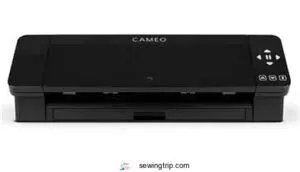
Silhouette Cameo 4 is your ticket to crafting freedom. With a 12-inch cutting width and powerful 5,000-gram force, it slices through fabric, vinyl, and cardstock like butter.
Its dual motors and matless cutting make even large projects a breeze. The Silhouette Studio software offers endless design possibilities, albeit with a learning curve.
While Bluetooth connectivity sometimes needs tweaking, its precision and quiet demeanor stand out. Perfect for those craving control over intricate designs, Cameo 4 truly is the quilter’s ally.
Best For: The Silhouette Cameo 4 is best for crafters who want a powerful, versatile cutting machine with precision and a wide range of materials compatibility.
- Matless Cutting: Offers flexibility and ease of use for larger projects.
- Powerful Cutting Force: Handles a wide range of materials, including thicker fabrics and vinyl.
- Quiet Operation: Ideal for use in quiet environments.
- Software Learning Curve: May require some time and effort to master.
- Bluetooth Connectivity Issues: Occasional connectivity problems may require troubleshooting.
- Price: More expensive than some other cutting machines on the market.
6. Cricut Maker 3 Bundle with Images
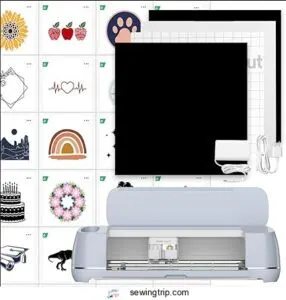
When you’re ready to tap into your inner crafting genius, the Cricut Maker 3 Bundle with Images is your go-to gizmo.
This versatile machine cuts over 300 materials, from delicate fabrics to robust chipboard, making it perfect for ambitious quilters.
It even works with Smart Materials for mat-free, mess-free creativity up to 12 feet long.
Plus, the included digital library of 30 images and free project templates makes it easy to get started with projects right away.
Consider clearing a dedicated space, though—it needs room to work its magic and achieve the desired results for ambitious quilters.
Best For: The Cricut Maker 3 Bundle with Images is best for crafters with a wide range of project ideas, from intricate paper crafts to large-scale fabric projects.
- Cuts over 300 materials, making it incredibly versatile.
- Smart Materials enable mat-free cutting for larger projects.
- Includes a digital library of images and free project templates for inspiration.
- Relatively expensive compared to other crafting machines.
- Requires dedicated workspace due to its size.
- Some users have reported occasional malfunctioning issues.
7. Cricut FabricGrip Cutting Mats
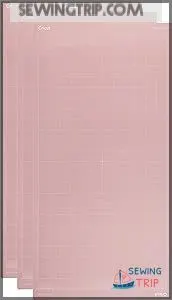
the Cricut FabricGrip Cutting Mat! This pink mat isn’t just pretty; it’s tough, boasting increased strength to handle fabrics like denim and canvas with ease.
Compatible with Cricut Maker and Explore machines, it’s designed for smooth material application and removal.
But remember, it’s a bit of a diva—keep it clean with a damp cloth, and avoid scraping to preserve its adhesive power. Treat it well, and it’ll keep your crafts looking fabulous!
Best For: Crafters who love working with a variety of fabrics, especially those tougher materials like denim and canvas.
- Durable and built to withstand heavy-duty fabrics.
- Designed for easy application and removal of materials.
- Compatible with Cricut Cutting Machines .
- Can be difficult to clean, requiring thorough cleaning with water to remove fabric residue.
- Some users have reported that the mat is tear-proof and hard to bend unless intentionally forced.
- May require careful handling to preserve adhesive power.
8. Sizzix Big Shot Plus Die Cutting Machine
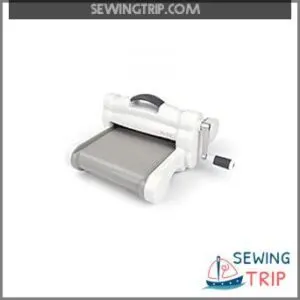
Looking to cut fabric like a pro?
The Sizzix Big Shot Plus Die Cutting Machine is your perfect partner with best die cutting machines reviewed
. It opens up a world of possibilities with its 9-inch A4-sized platform, allowing you to tackle projects with ease.
From crafting paper to balsa wood, this machine handles it all and delivers precise, crisp cuts.
Although a bit heavy, it offers a sturdy build that’s perfect for serious crafters. Just remember, it’s a bit of an attention hog for space! .
Best For: The Sizzix Big Shot Plus Die Cutting Machine is best for crafters who need a larger platform for cutting bigger materials and dies.
- Larger platform allows for cutting 8.5×11 paper without cutting it down.
- Sturdy and well-built with an easy-to-turn handle.
- Crisp cuts and precise results.
- Takes up more space than the standard 6-inch Big Shot.
- Can be expensive.
- Heavy and may be difficult to move.
Key Features to Consider
When you’re on the hunt for the perfect fabric cutter, there’s more to think about than just how sharp it is, especially when using a rotary cutting tool for precision and ease
.
You’ll want to weigh factors like manual versus electronic operation, cutting mechanism, and even how easy it’s to lug around.
To your quilting bee – because let’s face it, nobody wants to be the person struggling with a bulky machine while everyone else is already stitching away.
Manual or Electronic
You’ve got your top picks, but now let’s talk about the heart of the matter: manual vs. electronic fabric cutters. It’s like choosing between a trusty Swiss Army knife and a high-tech gadget.
Here’s what you need to know:
- Cost: Manual cutters are wallet-friendly upfront, but dies add up. Electronic machines are pricier but offer more bang for your buck.
- Precision: Both can deliver razor-sharp cuts, but electronic machines offer resizing options.
- Ease of Use: Manual cutters are straightforward, while electronic ones have a learning curve.
- Durability: Manual machines are workhorses, but electronic ones offer more features.
How It Cuts
Now that you’ve chosen between manual and electronic, let’s slice into how these machines actually cut. It’s like picking the right knife for your culinary masterpiece!
| Cutting Mechanism | Pros | Cons |
|---|---|---|
| Rotary Blade | Precise, versatile | Needs replacement |
| Die Cutting | Fast, consistent | Limited designs |
| Laser Cutting | Intricate details | Expensive, not for all fabrics |
Each method offers unique benefits, from the satisfying crunch of a die cutter to the laser-like precision of, well, a laser cutter. Your choice depends on your fabric type and project needs.
Other Features
Beyond cutting, fabric cutters pack a punch with extra features. You’ll love the storage options for your dies and applique shapes.
Some machines are quiet as a mouse, perfect for late-night crafting sessions.
Ease of use is key – look for user-friendly design space software. Don’t forget to check the warranty and cutting mat quality.
The Sizzix Big Shot even offers multi-craft use, letting you explore your creativity across various projects.
Variant of Fabric Cutting Machine
Let’s talk about the different flavors of fabric cutting machines. You’ve got manual vs. electric, die-cutting vs. rotary, and home vs. industrial options. It’s like choosing between a Swiss Army knife and a chef’s cleaver – each has its strengths.
Some machines, like the Gemini II Electric Cutting & Embossing, offer precision cuts and embossing on various materials, including paper, cardstock, vellum, and thin metal die cutting machine features.
For beginners, a versatile electric cutter might be your best bet. Pros might opt for a specialized industrial powerhouse.
Remember, the best fabric cutter is the one that fits your unique quilting style (Source).
Easy Carriage
You’ve mastered fabric types, but how about moving your cutting machine?
Easy carriage is a game-changer. Think of it as your fabric-cutting sidekick, ready to follow you anywhere.
The best fabric cutter machines offer portability without sacrificing power. Look for models with foldable designs, sturdy handles, and lightweight construction.
Some even come with travel-friendly cases, making it a breeze to take your crafting show on the road, thanks to travel-friendly cases .
Compact Dimension
Space-savvy quilters, rejoice! Compact fabric cutting machines pack a punch in a pint-sized package.
When choosing your cutting companion, consider these space-saving features:
- Portable design for easy storage
- Small footprint to maximize your workspace
- Lightweight construction for effortless transport
The Chickadee, for instance, offers a powerful motor in a smaller frame, perfect for tight spaces. Remember, good things come in small packages – just like your neatly trimmed fabric pieces!
Power and Accessories
While compact machines pack a punch, it’s the power and accessories that’ll make your fabric cutting a breeze.
Look for a robust motor that can slice through multiple layers like a hot knife through butter. Don’t forget about blade compatibility and cutting pads – they’re the unsung heroes of clean cuts.
And hey, who doesn’t love a machine with adapters that play nice with various accessories? It’s like having a Swiss Army knife for your quilting projects.
Fabric Cutter Machine Capabilities
You’ll be amazed at what fabric cutter machines can do for your quilting projects.
From precise cuts to time-saving efficiency, these nifty gadgets can transform your crafting experience.
And turn you into a quilting superhero faster than you can say "rotary cutter.
Perfection and Accuracy
Let’s talk precision.
The best fabric cutting machines offer die-cut precision that’ll make your quilting projects shine with the help of quilting time-savers quilting time-savers
.
With these cutting-edge tools, you’ll achieve:
- Razor-sharp edges for flawless seam allowances
- Perfect pattern alignment across multiple fabric layers
- Consistent cuts that eliminate guesswork and frustration
Say goodbye to wonky edges and hello to professional-quality results. These machines are like having a master tailor at your fingertips, giving you the control and mastery you crave in your crafting journey.
Time Saved and Efficiency
Fabric cutter machines are game-changers for quilters. You’ll slash cutting time and boost project speed, giving you more freedom to create.
Check out this comparison of time saved with different machines:
| Machine Type | Time Saved | Bulk Production |
|---|---|---|
| Manual | Moderate | Limited |
| Electronic | Significant | Extensive |
| Die-Cutting | High | Moderate |
With the right machine, you’ll optimize your workflow, manage time better, and tackle quilting patterns with ease. It’s like having a trusty sidekick for your crafting adventures!
Safety and Comfort
Now that you’ve conquered efficiency, let’s talk about your well-being.
Modern fabric cutters are designed with your comfort in mind. Ergonomic handles and user-friendly controls reduce hand fatigue, letting you quilt for hours without aching wrists (Source).
Blade safety features keep your fingers safe, while noise-reduction technology makes sure your creativity doesn’t disturb the household.
It’s like having a silent, safety-conscious assistant that keeps you in your crafting groove!
Increased Efficiency
While safety’s a top priority, you’ll love how fabric cutter machines turbocharge your quilting workflow. These time-saving dynamos are like having a personal assistant for your crafts.
Here’s how they amp up your efficiency:
- Chain piecing becomes a breeze
- Strip piecing simplifies complex patterns
- Batch cutting slashes prep time
- Precision cuts reduce errors and rework
Say goodbye to hand cramps and hello to speedy project completion. You’ll be churning out quilts faster than you can say "stitch in time"!
Versatility and Multi-Craft Use
You’ve got efficiency down pat, but let’s talk about the Swiss Army knife of your craft room.
Modern fabric cutters aren’t one-trick ponies. They’re multi-craft marvels, ready to tackle everything from quilting to home décor.
Imagine whipping up custom appliqués for machine embroidery one day, then crafting trendy vinyl decals the next. These versatile tools are your ticket to a world of DIY possibilities, freeing you to explore new creative horizons.
Choosing the Right Fabric Cutter Machine
You’re about to start a fabric-cutting adventure, and choosing the right machine is like finding the perfect dance partner for your quilting projects.
Whether you’re a seasoned pro or a newbie with dreams of perfectly cut shapes, we’ll help you explore fabric cutters to find your ideal match as a quilting project.
Types of Fabric Cutting Machines
Let’s explore fabric cutting machines. Your quilting journey can be a breeze with the right tool, such as the Sizzix Big Shot Pro Cutting Embossing Machine, a steel, aluminum, and metal alloy machine offering a 33cm opening for wider materials, ideal for industrial-strength fabric cutting.
Here’s a quick rundown of the main types:
- Manual cutters: Old-school charm, perfect for small projects
- Digital cutters: High-tech wizards for precision and speed
- Die-cut machines: Stamp-like cutting for repeated patterns
- Rotary cutters: Smooth operators for long, straight cuts
From electric fabric cutters to laser-guided marvels, there’s a machine to suit every quilter’s style and budget. Choose wisely, and you’ll be cutting fabric like a pro in no time.
Cutting Mechanism
Now that you’ve got a handle on the types of fabric cutters, it’s time to slice into the cutting mechanism.
The heart of your fabric cutting machine, this feature can make or break your quilting experience.
From die-cutting to rotary blades, each mechanism offers unique benefits. Die-cutting gives you precise shapes, while rotary blades offer flexibility for custom cuts.
Some high-tech options even use lasers or water jets for ultra-precise cutting.
Cutting Area and Size
While the cutting mechanism is important, size matters too!
The cutting area of your fabric cutting machine determines the scope of your quilting projects.
A 10" width accommodates various die sizes, from 5" x 10" to 10" x 24" .
A 10" width accommodates various die sizes, and think big: larger cutting areas let you tackle bigger quilt blocks and more ambitious projects.
But remember, with great size comes great responsibility – and potentially more fabric to manage!
Cutting Speed Vs. Accuracy
The precision-speed tango in fabric cutting can make or break your quilting groove.
You’re aiming for that sweet spot where accuracy meets efficiency.
High-speed cutters blaze through projects, but might leave you with raggedy edges.
Slower speeds offer pinpoint precision, perfect for intricate designs.
Consider your project type and budget when choosing.
Brand reputation often correlates with reliable performance.
Find your rhythm and cut with confidence!
Safety Features
Speed’s great, but let’s talk about keeping all your fingers! Your fabric cutting machine should be your trusty sidekick, not a medieval torture device.
Look for blade guards that’ll shield you from accidental nicks (Source).
Ergonomic designs reduce fatigue, while auto shut-off features prevent those "oops, I left it on" moments.
Don’t forget to read the user manual – it’s like a cheat code for safety.
Frequently Asked Questions (FAQs)
How often should I replace fabric cutter blades?
Sharp as a tack, your fabric cutter blade should slice through projects like butter.
You’ll want to replace it after cutting about four quilts.
Listen to your blade – when it starts tugging or shredding fabric, it’s time for a change.
Can fabric cutters handle multiple layers simultaneously?
Many fabric cutters can slice through multiple layers like a hot knife through butter.
With machines like the AccuQuilt GO!, you’ll breeze through quilting projects, cutting up to six layers at once.
Talk about time-saving magic!
Are fabric cutters suitable for small-scale businesses?
Like a tailor’s dream come true, fabric cutters are a perfect fit for small-scale businesses.
They’re affordable, user-friendly, and can boost your productivity in a snap.
You’ll be cutting with precision and speed in no time.
What maintenance is required for fabric cutting machines?
Regular maintenance keeps your fabric cutting machine purring like a well-oiled kitten.
Check blades daily, oil gears monthly, and schedule tune-ups based on usage.
Don’t let a dull blade turn your precise cuts into a fabric massacre!
Can fabric cutters work with specialty or delicate fabrics?
Did you know that 80% of quilters use specialized cutters?
Fabric cutters can indeed tackle delicate materials. You’ll need the right blade and settings, though.
Think of it like handling fine china – gentle touch, precise movements.
Your silks and chiffons are in good hands!
Conclusion
Imagine this: you, wielding the best fabric cutter machine, transforming piles of fabric into precise pieces effortlessly.
Whether you’re team manual or electronic, there’s a perfect match for your crafting style. Remember, it’s not just about clean cuts – it’s about boosting your creativity and efficiency.
So, explore our top picks, and find the fabric-slicing wizard that’ll revolutionize your quilting game.
With the right machine by your side, you’ll be crafting like a pro in no time. Happy cutting!

